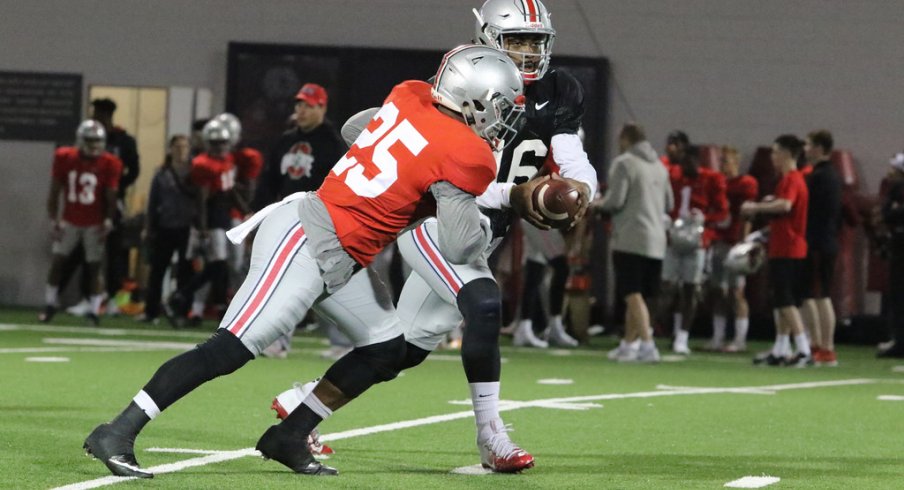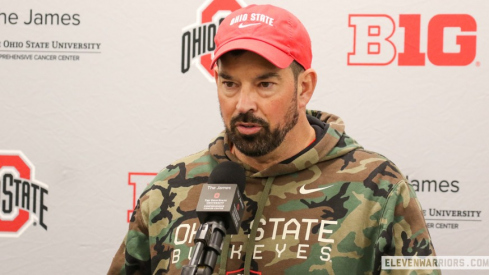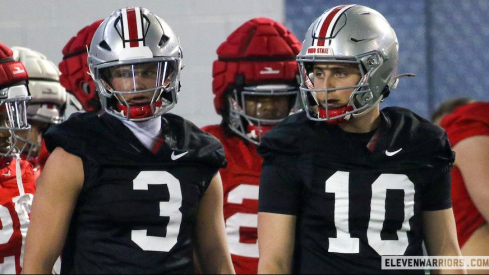After five seasons of the Urban Meyer era in Columbus, expectations for the Ohio State offense have changed.
Long gone are the conservative days of Tresselball, with the current students sitting in Block-O demanding 500 yards of offense every Saturday instead of preaching the gospel of field position and defense. Today, the Buckeyes are not only still expected to compete in for national titles year in and year out, they're expected to do so in a very specific manner.
For this, Meyer has only himself to blame. As one of the pioneers of spread-option football in the 2000s, the three-time national champion became a household name thanks to the way his devastating style of offense tore through the SEC before he took the head job in his home state.
Despite all the hype surrounding his hiring at Ohio State, Meyer somehow lived up to it, taking a team that went 6-7 the year before and marching straight through the Big Ten to an undefeated season. While Meyer hadn't exactly found the cupboard bare, with players like Ryan Shazier, John Simon, Bradley Roby, and a young quarterback named Braxton Miller already in the locker room, few expected the Buckeyes to come of age so quickly under their new coach.
Specifically, Miller's development from a part-time starter as a freshman in 2011 to two-time Big Ten MVP in 2012 and 2013 left both fans and opponents in awe. As perhaps the most gifted runner to ever line up under center in Columbus, Miller shredded defenses in Meyer's option scheme, rushing for over 2,300 yards and finding the end zone 25 times in those two seasons.
As we all know, Miller's career as a quarterback ended shortly after that 2013 campaign thanks to a shoulder injury, thrusting J.T. Barrett into the starting role as a redshirt freshman. Barrett would, of course, help lead the Buckeyes to a national title and also win the conference's MVP award that season, thanks in large part to his ability to properly read optioned defenders and distribute the ball to the playmakers around him.
| YEar | # of 20+ YArd Runs |
|---|---|
| 2012 | 26 |
| 2013 | 42 |
| 2014 | 36 |
| 2015 | 24 |
| 2016 | 30 |
Yet ever since Barrett took over, the Buckeye offense has looked a bit different. Obviously, Barrett is not quite the same running threat in the open field as Miller. However, despite filling the depth chart with some of the nation's best talents over the past five years, the Buckeye offense seems to have become less explosive than those first two seasons under Meyer. Specifically, despite a continued reliance on the option to get the Buckeye offense out of countless jams over the past few years, the design of such plays has become pedestrian by Meyer's standards.
As anyone who reads this space knows, the Buckeyes rely heavily on the tight zone run concept as the absolute bedrock of their offensive identity. Yet after Bud Foster and the Virginia Tech defense famously stifled Ohio State in the 2014 home opener with a 'Bear' front that placed three linemen over the OSU center and guards, seemingly every opponent over the next two seasons would attempt to copy the blueprint, albeit with far less success.
While Meyer and coordinator Tom Herman found new ways to attack that look, specifically with schemes like Dart, Buck Sweep, and the Power-Read option concept that would become core concepts for that 2014 team, other option wrinkles we'd seen before were put on the shelf. But over the next two seasons, the OSU attack would seem relatively toothless at times, unable to manufacture yards when they often needed them most and throwing together a grab-bag approach to play-calling that left many bewildered.
Yet while the staff looked for answers, many options were right in front of them. During Meyer's first two seasons with Miller at quarterback, the Buckeyes unleashed a bevy of option plays built off the basic tight zone blocking scheme. Some wrinkles were minor, having mostly to do with the formation and the alignment of the tight end and who he left unblocked for the QB to read. But others seem like long lost relics to this point, such as the 'Wade' and 'Tres' triple option concepts that pulled the 'H' receiver into the backfield.
While some coaches may argue that putting three players in the backfield and an inline tight end may take away any benefits of spread formations, the first play in the video above shows what motion can do to stress a defense, as the Hoosiers had six players lined up away from the play, leaving no one to tackle the pitch man.
The real benefit of concepts like this one, though, is the second play in the example above, as Carlos Hyde was able to gallop for a big first down as the simple threat of the motion man taking the option pitch completely discombobulated the defense, allowing the runner to find a gaping hole filled only by a lunging linebacker who wasn't able to get there in time.
While the 2012 and 2013 offenses may not have had the desired run/pass balance many desired and expected, thanks in large part to Miller's limitations as a passer, the OSU staff was forced to get more creative, adopting run-pass-options (RPOs) early on.
It's hard not to watch the examples above and imagine Curtis Samuel or Miller (once he made the move to receiver) filling the roles played by Philly Brown. But during each of the past two seasons, the Buckeyes failed to execute on one of Meyer's core philosophies as a coach (get the ball in the hands of your best players), because they also seemed to fail at another (finding innovative ways to create conflict for the defense).
As shown in this space last month, Meyer emphasizes creating conflict specifically for defensive ends by leaving them unblocked in the option game. As the examples above show, he already has a number of ways to do so sitting in his playbook. But, he and new coordinator Kevin Wilson shouldn't only look at their own old tape when trying to figure out how to make like easier for Barrett in his final season wearing scarlet and gray.
No longer are Meyer and Wilson the only titans of the spread-option world, with many of their core theories now incorporated into every offensive meeting at the high school, college, and even the pro levels. A quick survey of the landscape should offer the duo myriad ways to attack unblocked defensive ends like never before.
For starters, they could look to the Tennessee Titans, where former Heisman-winning spread QB Marcus Mariota has seemed to turn the corner in an NFL offense. One way his coaches have helped was to incorporate a simple backside read into the 'Power-O' concept (a favorite of Meyer's), as the pulling guard brings the inside linebacker with him and leaving no defenders on the backside. This allows Mariota to pick up a quick 11 yards after simply reading the end:
#Titans: Power + QB Read. LB moves with the guard pull. That's a quick 11-yards for Mariota. pic.twitter.com/bI4jOZqxOF
— Matt Bowen (@MattBowen41) July 11, 2017
But the Buckeye coaches shouldn't have to look back too far to find some ideas to incorporate from their own level. Not only did the Clemson offense thrash the Buckeyes in the Fiesta Bowl, putting on a spread-option clinic with Deshaun Watson at the helm, they did so with an offense that can easily be compared to Ohio State's.
While the Tigers certainly had plenty of talent in their huddle, their innovative efforts inspired one of the most ardent opponents of the 'spread' movement - Nick Saban. In the college football playoffs, all four teams relied heavily on option concepts that looked little like the ones Meyer was calling 15 years ago.
Instead, Clemson, Alabama, and Washington all built new option elements into existing blocking schemes, such as the 'Power-Toss' concept which looks like a speed option to the outside but gives the QB the option to run up the B-gap behind a pulling guard, augmenting the classic 'power-read' concept.
Of course, there are plenty of other places to look for inspiration than just those at the top. New Mexico's option offense incorporates flexbone, wishbone, veer, and pistol concepts all at once, delivering a devastating running attack that has helped resurrect a program once left for dead. The super-spread offenses of Baylor, Tulsa, and others continue to re-write the rules for 'spread' formations, with receivers lined up so far outside that defenses are left moving laterally so often that running lanes virtually open on their own.
But wherever Meyer and his staff look for inspiration, they must do so knowing that standing pat on their existing schemes won't be enough. As has been the case since the dawn of the game, defenses have caught up to the basics of the spread attack Meyer pioneered. For the Buckeyes to stay on top, they'll first have to stay ahead.



